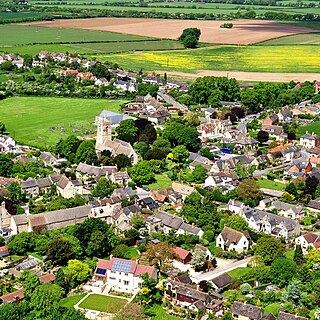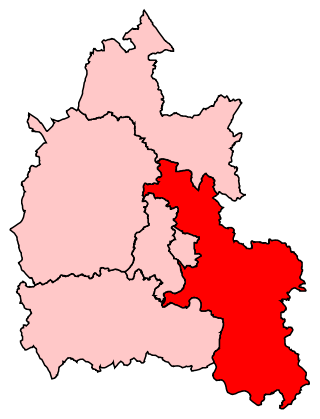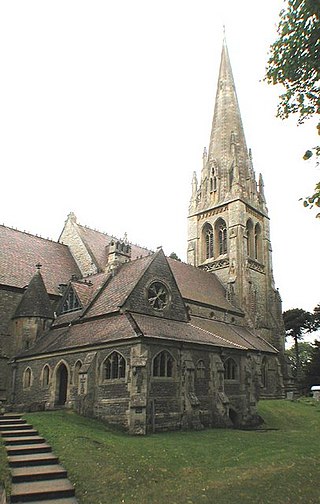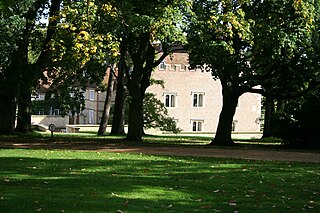
Oxfordshire is a ceremonial county in South East England. The county is bordered by Northamptonshire and Warwickshire to the north, Buckinghamshire to the east, Berkshire to the south, and Wiltshire and Gloucestershire to the west. The city of Oxford is the largest settlement and county town.

Culham is a village and civil parish in a bend of the River Thames, 1 mile (1.6 km) south of Abingdon in Oxfordshire. The parish includes Culham Science Centre and Europa School UK. The parish is bounded by the Thames to the north, west and south, and by present and former field boundaries to the east. It is low-lying and fairly flat, rising from the Thames floodplain in the south to a north-facing escarpment in the north up to 260 feet (80 m) above sea level. The 2011 Census recorded its population as 453.

Henley is a constituency in Oxfordshire represented in the House of Commons of the UK Parliament since 2008 by John Howell, a Member of Parliament from the Conservative Party.

Deddington is a town and civil parish in Oxfordshire, England. The town lies 6 miles (10 km) south of Banbury. The parish includes two hamlets: Clifton and Hempton. The 2011 Census recorded the parish's population as 2,146. Deddington has a commercial centre including a market place, which hosts a popular monthly farmer’s market. It has been a market town probably since the 12th century. One of the Hundred Rolls of King Edward I from 1275–76 records Deddington as a borough. It has a deli, coffee shop, restaurant, three pubs and a town hall. Its football team is called Deddington Town FC.

Clifton Hampden is a village and civil parish on the north bank of the River Thames, just over 3 miles (5 km) east of Abingdon in Oxfordshire. Since 1932 the civil parish has included the village of Burcot, 1 mile (1.6 km) east of Clifton Hampden. The 2011 Census recorded the parish population as 662.

Clifton Hampden Bridge is a road bridge crossing the River Thames in Clifton Hampden, Oxfordshire, England, situated on the reach below Clifton Lock. Originally it joined Oxfordshire on the north bank with Berkshire on the south but in 1974 the area on the south bank was transferred from Berkshire to Oxfordshire. It is a Grade II* listed building.

The Barley Mow is a historic public house, just south of the River Thames near the bridge at Clifton Hampden, Oxfordshire, England.

Culham railway station serves the village of Culham in Oxfordshire, England. It is on the Cherwell Valley Line between Didcot Parkway and Banbury, 56 miles 17 chains (90.5 km) from London Paddington. It is served by local train services provided by Great Western Railway.

Emmington is a village in the civil parish of Chinnor, in the South Oxfordshire district, in the county of Oxfordshire, England. It is about 4.5 miles (7 km) southeast of Thame. In 1931 the parish had a population of 41. On 1 April 1932 the parish was abolished and merged with Chinnor.
Glympton Park is a former deer park at Glympton, 3.5 miles (5.6 km) north of Woodstock, Oxfordshire, England. It includes Glympton House and has a 2,000 acres (810 ha) estate including the village of Glympton, its Norman parish church of St. Mary, 32 stone cottages and 167 acres (68 ha) of parkland.

Chiselhampton is a village in the civil parish of Stadhampton, on the River Thame, in the South Oxfordshire district, in the county of Oxfordshire, England. It is about 6 miles (10 km) southeast of Oxford. In 1931 the parish named Chislehampton had a population of 136. On 1 April 1932 the parish was abolished and merged with Stadhampton.

Burcot is a hamlet in the civil parish of Clifton Hampden, in the South Oxfordshire district, in the county of Oxfordshire, England. It is on the left bank of the River Thames. In 1931 the parish had a population of 187.

Henry Woodyer (1816–1896) was an English architect, a pupil of William Butterfield and a disciple of A. W. N. Pugin and the Ecclesiologists.

Aldenham House is an English country house in Elstree, just south-east of Aldenham village and west of Borehamwood, Hertfordshire, England. It was the seat of the Gibbs family, who were the Barons Aldenham, and is now a main building of the Haberdashers' Boys' School, while its estate accommodates the other school buildings, the Haberdashers' School for Girls, the Lister Institute, and the Hilfield Reservoir.

Rycote House the manor of Rycote, Oxfordshire, England, was a Tudor country house. First built in the early 16th century, the present site was rebuilt in the 1920s.
Longworth House is an historic country house at Longworth in the English county of Oxfordshire. It is a Grade II listed building.

Tubney is a small village and former civil parish, now in the parish of Fyfield and Tubney, in the Vale of White Horse district, in Oxfordshire, England. It lies about 3 miles west of Abingdon-on-Thames, just south of the A420 road from Oxford to Faringdon, 9 miles (14 km) southwest of Oxford. In 1951 the parish had a population of 215.
Christopher Henry Gibbs was a British antiques dealer and collector who was also an influential figure in men's fashion and interior design in 1960s London. He has been credited with inventing Swinging London, and has been called the "King of Chelsea" and "London's most famous antiques dealer". The New York Times described him as a "man of infinite taste, judgment and experience, the one who introduced a whole generation to the distressed bohemian style of interior design."

Wardington Manor lies between Lower and Upper Wardington in Oxfordshire. The house dates from the middle of the 16th century or possibly earlier. The house was remodelled in 1665 and twice early in the 20th century.

Brightwell Manor is a country house in the village of Brightwell-cum-Sotwell, Oxfordshire, England. The back dates to around the mid-seventeenth century, or possibly earlier as there is a date of 1605 on the rear. The front was built in the mid-eighteenth century. It has been a Grade II listed building since 1952. It is owned by former British prime minister Boris Johnson and his wife Carrie Johnson.

















